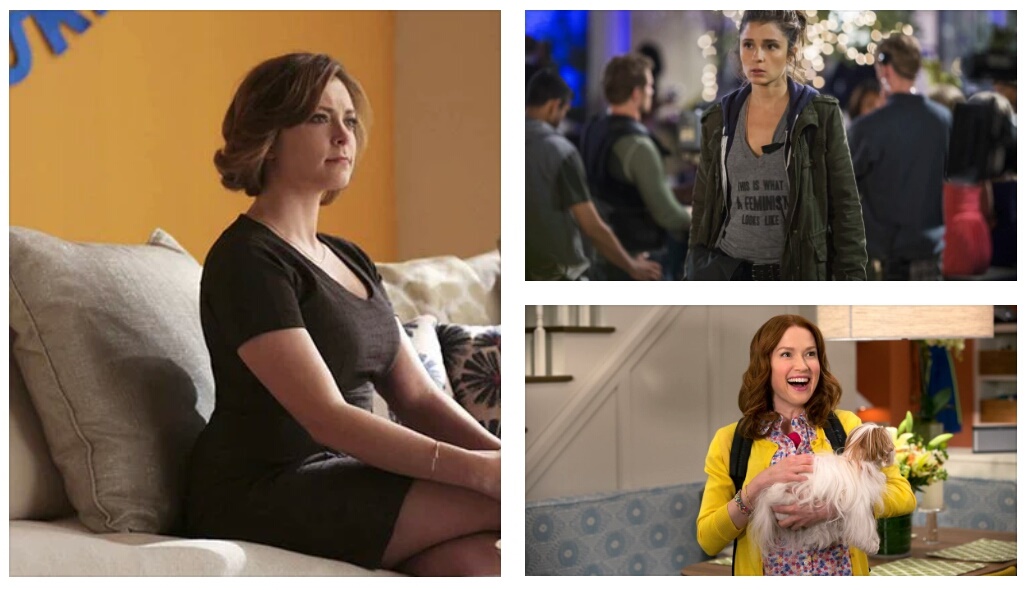This guest post is written by Scarlett Harris.
With the sleeper success of Crazy Ex-Girlfriend, the increased focus on Kimmy Schmidt’s PTSD this season on Unbreakable Kimmy Schmidt, and Rachel Goldberg’s mental illness on UnREAL, there seems to be a rise in depictions of mental health — in particular, women’s mental health — on television.
Crazy Ex-Girlfriend deals perhaps most explicitly with mental health. Unfortunately, the series has an awful, ableist title. Unhappy in her high-powered career as a New York lawyer, Rebecca Bunch bumps into her summer camp boyfriend Josh Chan in the street and decides to follow him to West Covina, California, though she repeatedly claims that’s not the reason for her sea change. There we see her transition through depression, anxiety, and “smidges of [obsessive] compulsive disorder” in her quest to win back Josh, as Crazy Ex-Girlfriend’s co-creators Rachel Bloom (who plays Rebecca) and Aline Brosh McKenna told Vulture.
The hormones in play when you’re falling in love — increased dopamine levels and a decrease in serotonin — mirror those released when taking a hit of cocaine and having obsessive compulsive disorder. Not only is Crazy Ex-Girlfriend a commentary on Rebecca’s mental health struggles but it covertly examines the general absurdity of romance in our society. Romantic comedies, the glorification of violent couples such as Sid and Nancy and Harley Quinn and The Joker, and excusing playground bullying as affection all equate intense passion, and at times even abuse, with true love. Bloom and Brosh McKenna told Vulture that many characters in rom-coms exhibit extremely unhealthy or destructive behavior and they differentiate Rebecca’s behavior from this.
That brings us to UnReal, created by Marti Noxon and Sarah Gertrude Shapiro, which finished its second season on Lifetime. Despite its well–documented problems this season regarding race and its depiction of people of color, the show is another that portrays a woman living and working with mental illness to varying degrees of success. As Alyssa Rosenberg writes at The Washington Post:
“The most interesting element of UnREAL, though… is the idea that mental illness is an appropriate response to certain social conditions and expectations for modern women. The Bachelor-style show Rachel works for pushes the women who appear on it to their absolute limits, forcing them to adopt artificial personas and suppress their feelings to compete for the affections of a man who’s appearing on the show only to boost his business. Being the person involved in manipulating other women is a highly unpleasant task. And an on-air meltdown Rachel suffered shortly before the events of the first season of UnREAL may actually be the sanest and most humane possible reaction to the job.”
Though UnReal hasn’t done Rachel — nor most of its other characters, for that matter — justice this season, she manipulates people to get what she wants and struggles with mental illness internally in equal measure, showing that a woman with mental illness doesn’t have to be a traditionally sympathetic character.
On the other hand, though, Kimmy Schmidt is a character we can more easily empathize with due to her jovial, almost childlike (which is another trope of women with mental illness in itself) demeanor. Unbreakable Kimmy Schmidt took us by surprise this season as it dealt savilly with the fallout from Kimmy’s imprisonment by Reverend Richard Wayne Gary Wayne. Bread crumbs like Kimmy’s stress burping, her behavior around war veteran Keith, and her involuntary responses to getting intimate with Dong are scattered throughout the earlier parts of season two, which lead to Kimmy seeking therapy from Dr. Andrea (Tina Fey, who also co-created the series) in later episodes. Kimmy’s reluctance to see a psychiatrist is realistic, as is the turmoil she increasingly sees her life devolve into as she ignores her problems. For so long, Kimmy played the role of therapist in her friends’ and fellow captives’ lives that she can’t see how much she herself needs one.
By bringing mental health issues to the forefront — along with other complex portrayals, such as those in Being Mary Jane, You’re the Worst, Bojack Horseman, Girls, Lady Dynamite, and Homeland — television is changing the perception of women with mental illness from fetishized objects to more nuanced and realistic portrayals, at once granting greater representation to women with disabilities and hopefully reducing the stigma of mental illness.
Scarlett Harris is an Australian writer based in New York City. You can follow her on Twitter @ScarlettEHarris and read her previous published work at her website The Scarlett Woman.


1 thought on “The Rise of Women with Mental Illness in TV Series”
Comments are closed.